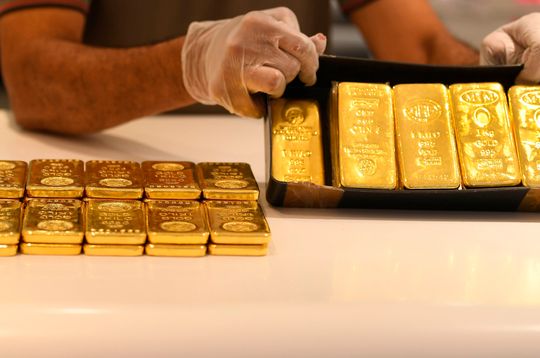Most-active gold contract marks highest finish since Aug. 5
Gold futures settled higher on Monday, supported partly by weakness in the U.S. dollar, leading prices back above a key market above $1,800 for the first time in over two weeks.
“A significant reversal in the dollar and broad-based risk on psychology has lifted gold and the rest of the metals complex off fundamental reasons to start the new trading week,” analysts at Zaner metals wrote in Monday’s market update. “Others are suggesting that the ongoing surge in the delta variant infections is still threatening the global economy and that, in turn, is providing flight to quality buying interest in gold.”
However, with global equities higher, Treasurys and the dollar lower, “we do not see the safe haven force operating in gold” at the start of the week, they said. “At least in the coming two sessions, the gold and silver trade might avoid the subject of U.S. tapering until the Jackson Hole symposium begins…”
December gold GCZ21, -0.16% rose $22.30, or nearly 1.3%, to settle at $1,806.30 an ounce, with the most-active contract marking its highest finish since Aug. 5, according to FactSet data. Prices on Friday logged a weekly advance of 0.3%, its second in a row.
Moves higher for the yellow metal come ahead of an economic policy symposium where Federal Reserve Chairman Jerome Powell on Friday may indicate that the central bank will slow monthly purchases of Treasurys and mortgage-backed securities that had helped to prop up financial markets during the height of pandemic-induced selling in spring of 2020.
“Why is the Jackson Hole symposium so crucial? The reason is simple: gold traders, as well as stocks or bond investors, are expecting further guidance in regard to the Federal Reserve’s tapering timeline,” wrote Carlo Alberto De Casa, market analyst at Kinesis, in a Monday research note.
“Any dovish indication could help gold to continue its recent rebound, while an expedited beginning of the tapering procedure could be seen as a negative catalyst for bullion,” the analyst wrote.
Helping lift gold was a softer dollar, as measured by the ICE U.S. Dollar Index DXY, 0.08%, a gauge of the currency against a basket of a half-dozen rivals. The dollar index was down 0.3%.
A weaker dollar can make assets priced in the currency, like gold, appear more attractive to overseas buyers.
The jump for gold prices isn’t just about the dollar Monday, said Adrian Ash, director of research at BullionVault, adding that bullion has also hit “multi-week highs priced in euros and yen, and it’s now 8% higher from August’s flash crash in terms of the British pound.”
After the Reserve Bank of New Zealand delayed its rate hike because of the delta wave last week, comments from Dallas Fed President Rob Kaplan on Friday that he may rethink his call for Fed QE tapering are “clearly a key driver,” said Ash. “Jackson Hole will likely confirm the new dovishness among central banks everywhere, helping support and boost gold prices as long-term interest rates lag the pace of inflation by an ever-wider margin and the real value of cash in the bank shrinks at a faster pace.”
Gold prices briefly pared gains shortly after data Monday showing U.S. businesses suffered some erosion in growth in August for the third month in a row, before heading back up.
A survey of service-oriented companies fell to an eight-month low, with the index dropping to 55.2 in August from 59.9 in prior month, IHS Markit said Monday.
Meanwhile, silver for September delivery SIU21, -0.32% tacked on 54 cents, or nearly 2.4%, higher at nearly $23.66 an ounce, following weekly decline of 2.8% on Friday.
September copper HGU21, -0.28% added 2.4% to $4.24 a pound. October platinum PLV21, -0.50% rose 2% to $1,014.10 an ounce.
September palladium PAU21, +0.39% climbed sharply by 4.8% at $2,385.10 an ounce, to recoup some of its recent losses, after posting declines in each of the previous five sessions.
Seeing U.S. equities extend their recovery from last week will “likely dampen recent selling interest” for palladium, said analysts at Zaner. But the markets are anticipating disappointing Chinese economic data due to the ongoing delta variant infection rise, and the “bear camp will be difficult to fully unseat unless the equity markets continue to rally.”

